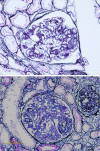Two brothers with collagenofibrotic glomerulopathy
- PMID: 28509277
- PMCID: PMC5413714
- DOI: 10.1007/s13730-014-0145-y
Two brothers with collagenofibrotic glomerulopathy
Abstract
Collagenofibrotic glomerulopathy is a rare glomerular disease characterized by extensive accumulation of atypical type III collagen fibers within the mesangial matrix and subendothelial space. Laboratory evaluation of this disease shows a marked increase in serum procollagen III peptide (P III P) levels. Here, we report the case of two brothers with collagenofibrotic glomerulopathy confirmed by histology. Patient 1 presented with proteinuria and hypertension and patient 2 presented with nephrotic-range proteinuria. Immunohistochemistry revealed strong staining for antibodies to type III collagen in the widened subendothelial spaces in both patients. Electron microscopy revealed numerous collagenous fibers in the mesangium and subendothelial space. P III P levels were elevated in both patients. Most reported cases of collagenofibrotic glomerulopathy, including the adult-onset type, have been sporadic. Within the limits of our literature search, this is only the third report of adult siblings with collagenofibrotic glomerulopathy confirmed by histology. This report indicates that it may be beneficial to measure serum P III P levels in the siblings of patients diagnosed with adult-onset collagenofibrotic glomerulopathy.
Keywords: Collagen type III glomerulopathy; Collagenofibrotic glomerulopathy; Familial nephropathy; Procollagen III peptide; Type III collagen.
Figures




Similar articles
-
Collagenofibrotic Glomerulopathy.Intern Med. 2021 Mar 15;60(6):911-915. doi: 10.2169/internalmedicine.6090-20. Epub 2020 Oct 14. Intern Med. 2021. PMID: 33055489 Free PMC article.
-
Collagenofibrotic glomerulopathy.Clin Kidney J. 2015 Oct;8(5):543-7. doi: 10.1093/ckj/sfv061. Epub 2015 Aug 7. Clin Kidney J. 2015. PMID: 26413279 Free PMC article.
-
Collagenofibrotic glomerulopathy: clinicopathologic overview of a rare glomerular disease.Am J Kidney Dis. 2007 Apr;49(4):499-506. doi: 10.1053/j.ajkd.2007.01.020. Am J Kidney Dis. 2007. PMID: 17386317 Review.
-
Collagenofibrotic glomerulopathy - Case report with review of literature.Indian J Nephrol. 2011 Jan;21(1):52-5. doi: 10.4103/0971-4065.78080. Indian J Nephrol. 2011. PMID: 21655172 Free PMC article.
-
Collagenofibrotic (Collagen Type III) glomerulopathy in association with diabetic nephropathy.Saudi J Kidney Dis Transpl. 2017 Jul-Aug;28(4):898-905. Saudi J Kidney Dis Transpl. 2017. PMID: 28748894 Review.
Cited by
-
Collagenofibrotic Glomerulopathy.Intern Med. 2021 Mar 15;60(6):911-915. doi: 10.2169/internalmedicine.6090-20. Epub 2020 Oct 14. Intern Med. 2021. PMID: 33055489 Free PMC article.
-
Biochemical composition of the glomerular extracellular matrix in patients with diabetic kidney disease.World J Diabetes. 2022 Jul 15;13(7):498-520. doi: 10.4239/wjd.v13.i7.498. World J Diabetes. 2022. PMID: 36051430 Free PMC article. Review.
References
-
- Arakawa M, Fueki H, Hirano H, Sato M, Yamagishi T, Matsuda H, Kamimura S, Suzuki M, Yamagishi Y, Yamashita M, Nakagawa S. Idiopathic mesangio-degenerative glomerulopathy. Jpn J Nephrol. 1979;21:914–915.
LinkOut - more resources
Full Text Sources
Other Literature Sources

